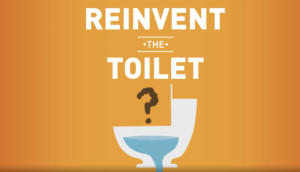
Reinvent the Toilet Challenge
More than 2 billion people lack access to clean water and sanitation around the world.
Through his foundation’s “Reinvent the Toilet Challenge,”
 Gates has given millions to teams seeking to develop waterless toilets in the last several years. To be entered into the challenge, toilets had to cost less than 5 cents a day to operate, without the need for external electricity or running water.
Gates has given millions to teams seeking to develop waterless toilets in the last several years. To be entered into the challenge, toilets had to cost less than 5 cents a day to operate, without the need for external electricity or running water.
In 2011, the first year of the challenge, Gates awarded the top prize to the California Institute of Technology’s prototype of a self-contained, solar-powered toilet. The toilet produces enough energy to run an electric reactor that can break down human waste and produce hydrogen, according to Gates’ blog. Among the other finalists: A toilet developed at the University of Toronto that combusts waste with ultra-violet light, and a toilet developed at a university in the United Kingdom that transforms fecal matter into a “biological charcoal,” which can be used as fertilizer or even a fuel source.
Each of the finalists received a $400,000 grant from the Gates Foundation to continue improving their prototypes.
Seven years later, Gates is testing more prototypes in poor, urban communities in India and across Africa. He recently awarded a $7 million grant to a toilet developed by two Duke University professors, and he gave Duke $3.7 million to establish a new Sanitation Technology cluster, focusing on interdisciplinary research into toilets, according to Inside Philanthropy.
And, in 2012, Gates sank $710,000 into a toilet developed at Cranfield University, called The Nano Membrane Toilet. That toilet — which received another substantial grant at the end of 2016, is now being field tested in Ghana.
Here’s how the toilet works:
What do you think?